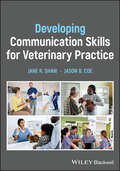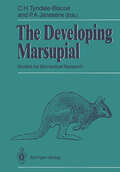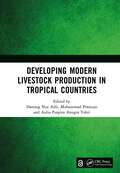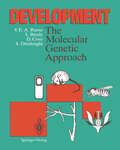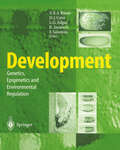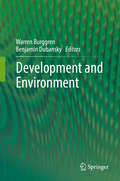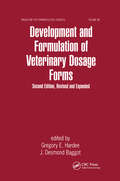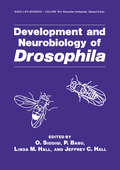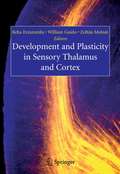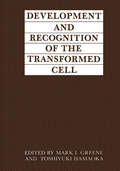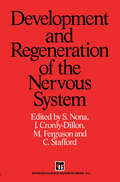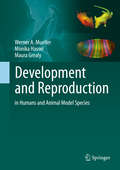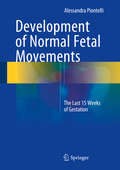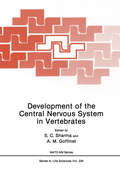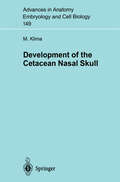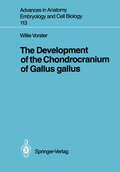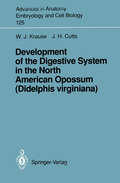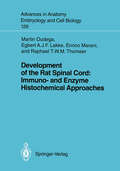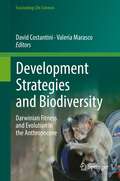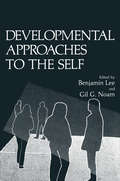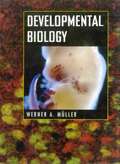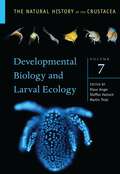- Table View
- List View
Developing Communication Skills for Veterinary Practice
by Jane R. Shaw Jason B. CoeDeveloping Communication Skills for Veterinary Practice Developing Communication Skills for Veterinary Practice provides a thorough grounding in practical communication principles for client and team interactions, and helps veterinarians and staff take their communication skills to the next level through self-development and coaching colleagues. The book describes specific evidence-based techniques, gives examples of their use, and demonstrates how to use each skill in the clinical setting, with learning activities to put into practice. It covers every mode of communication, including face-to-face, virtual, telephone, and written communication. Organized by the tasks of the clinical appointment, each chapter showcases specific communication skills. The book introduces a communication toolbox of 20 key communication skills, which can be applied to any area of veterinary practice or veterinary career path. The book: Defines each communication skill, demonstrates techniques, and provides examplesEmphasizes the importance of communicating effectively with clients and colleaguesProvides a process and structure for coaching communication with colleaguesDiscusses client and team interactions using many methods, including in-person meetings, telephone conversations, and emailsOutlines best practices for effectively communicating using technology Developing Communication Skills for Veterinary Practice is an invaluable resource for veterinary professionals at any level seeking to develop their communication skills and improve clinical outcomes.
Developing Communication Skills for Veterinary Practice
by Jane R. Shaw Jason B. CoeDeveloping Communication Skills for Veterinary Practice Developing Communication Skills for Veterinary Practice provides a thorough grounding in practical communication principles for client and team interactions, and helps veterinarians and staff take their communication skills to the next level through self-development and coaching colleagues. The book describes specific evidence-based techniques, gives examples of their use, and demonstrates how to use each skill in the clinical setting, with learning activities to put into practice. It covers every mode of communication, including face-to-face, virtual, telephone, and written communication. Organized by the tasks of the clinical appointment, each chapter showcases specific communication skills. The book introduces a communication toolbox of 20 key communication skills, which can be applied to any area of veterinary practice or veterinary career path. The book: Defines each communication skill, demonstrates techniques, and provides examplesEmphasizes the importance of communicating effectively with clients and colleaguesProvides a process and structure for coaching communication with colleaguesDiscusses client and team interactions using many methods, including in-person meetings, telephone conversations, and emailsOutlines best practices for effectively communicating using technology Developing Communication Skills for Veterinary Practice is an invaluable resource for veterinary professionals at any level seeking to develop their communication skills and improve clinical outcomes.
The Developing Marsupial: Models for Biomedical Research
by C. H. Tyndale-Biscoe P. A. JanssensMarsupials are excellent objects for studies on developmental processes in all mammals including humans. Marsupials are very immature at birth and undergo most of their development in a pouch where they can be manipulated in a variety of ways without affecting the mother. Most of these studies are on systems which largely mature before birth in eutherian mammals and are consequently difficult to investigate. Attention is also drawn to certain features peculiar to adult marsupials: e.g., they continue to grow throughout adult life, valuable for studies on growth mechanisms, and furthermore the composition of marsupial milk changes radically through lactation, most important in studies of hormonal regulation of milk composition and secretion.
Developing Modern Livestock Production in Tropical Countries: Proceedings of the 5th Animal Production International Seminar (APIS 2022), Malang, Indonesia, 10 November 2022
by Danung Nur Adli Muhammad Pramujo Anugra Yekti, Aulia PuspitaThe Animal Production International Seminar (APIS) is the first international conference held by the Faculty of Animal Science, Universitas Brawijaya. APIS was held for the first time in 2010 and was repeated every three years. In 2022, the 5th APIS was organized as an online meeting. The Faculty of Animal Science, Universitas Brawijaya, is optimistic that the results of the 5th APIS will just be as successful as the 4th APIS in 2019. The theme of 5th APIS was "Developing Modern Livestock Production in Tropical Countries". The 5th APIS discussed matters related to strategies for developing modern livestock production in several tropical countries. The participants of 5th APIS, including keynote speakers and invited speakers, are from various countries (tropical and sub-tropical). These proceedings present the selected papers from the 5th APIS conference.
Developing Modern Livestock Production in Tropical Countries: Proceedings of the 5th Animal Production International Seminar (APIS 2022), Malang, Indonesia, 10 November 2022
The Animal Production International Seminar (APIS) is the first international conference held by the Faculty of Animal Science, Universitas Brawijaya. APIS was held for the first time in 2010 and was repeated every three years. In 2022, the 5th APIS was organized as an online meeting. The Faculty of Animal Science, Universitas Brawijaya, is optimistic that the results of the 5th APIS will just be as successful as the 4th APIS in 2019. The theme of 5th APIS was "Developing Modern Livestock Production in Tropical Countries". The 5th APIS discussed matters related to strategies for developing modern livestock production in several tropical countries. The participants of 5th APIS, including keynote speakers and invited speakers, are from various countries (tropical and sub-tropical). These proceedings present the selected papers from the 5th APIS conference.
Development: The Molecular Genetic Approach
by Vincenzo E.A. Russo Stuart Brody David Cove Sergio OttolenghiAs a result of the molecular genetic analysis of development similar mechanisms for the regulation of gene expression are found in a wide range of organisms. In "Development - the Molecular Genetic Approach" these common mechanisms as well as the specific events leading to a differentiated cell are described. Particular items treated are, for example, how asymmetry is achieved, how cell size is determined, how cell division is controlled, how cell lineage influences development, how cells know their position, and how cells communicate during development.
Development: Genetics, Epigenetics and Environmental Regulation
by F. Salamini V. E. A. Russo D. J. Cove L. G. Edgar R. JaenischStudies of organisms have led to a greatly improved understanding of the genetic mechanisms underlying developmental processes, and the epigenetic and environmental influences on these processes. This second edition reviews these three levels and their relative importance to give the reader a clear picture of one of the most exciting areas of current biological research.
Development and Environment
by Benjamin Dubansky Warren BurggrenRather than a loosely connected list of facts/topics, this book addresses virtually every field that involves the use of developing animals in environmental science. In doing so, it will help define the scientific collective within these fields to both those readers who are "outside" of a particular field (students and professionals alike) and those who work within said field, where multiple iterations of the same job description exist. Both the content and choice of authors fully support this goal, as the editors and contributing authors represent contemporary thought and experimentation in their respective fields – ranging from developmental physiology through environmental toxicology to medicine. As such, this work will appeal to a broad audience, including any scientist or trainee interested in the nexus of environment, development and physiology.
Development and Formulation of Veterinary Dosage Forms
by Gregory E. Hardee; J. Desmond BaggotAlthough the United States (U.S.) and the more developed nations of the remainder of the world are blessed with a variety of pharmaceuticals, feed additives, and biological products to treat, prevent, and control animal diseases, there is a healthy desire among persons involved in animal health issues to increase our animal medicine chest. The interest stems from the desire to efficiently produce food that is safe and plentiful and from the desire to have more and better government-approved products available for the prevention and treatment of diseases of dogs, cats, and horses and for an increasing variety of minor animal species. For the animal health industry, increased drug availability means broader markets, increased revenues, and an opportunity to better serve their customers. For the veterinarian, more animal health products means that he or she is better able to treat the usual and the unusual conditions, and to prevent animal disease and suffering. No doubt, we are all winners when new technology and industrial and regulatory initiatives hasten the availability of safe and effective animal health products.
Development and Formulation of Veterinary Dosage Forms (Drugs And The Pharmaceutical Sciences Ser.)
by Gregory E. Hardee J. D. BaggotAlthough the United States (U.S.) and the more developed nations of the remainder of the world are blessed with a variety of pharmaceuticals, feed additives, and biological products to treat, prevent, and control animal diseases, there is a healthy desire among persons involved in animal health issues to increase our animal medicine chest. The interest stems from the desire to efficiently produce food that is safe and plentiful and from the desire to have more and better government-approved products available for the prevention and treatment of diseases of dogs, cats, and horses and for an increasing variety of minor animal species. For the animal health industry, increased drug availability means broader markets, increased revenues, and an opportunity to better serve their customers. For the veterinarian, more animal health products means that he or she is better able to treat the usual and the unusual conditions, and to prevent animal disease and suffering. No doubt, we are all winners when new technology and industrial and regulatory initiatives hasten the availability of safe and effective animal health products.
Development and Neurobiology of Drosophila: (pdf) (Basic Life Sciences #16)
by O. Siddiqi P. Babu Linda M. Hall Jeffrey C. HallDevelopment and Plasticity in Sensory Thalamus and Cortex
by Reha Erzurumlu William Guido Zoltan MolnarThis volume provides an update on the multitude of technical and experimental approaches in understanding the development and plasticity of the mammalian sensory thalamus and neocortex. The focus is on visual and somatosensory thalamus and neocortex in rodents and carnivores, and functional imaging studies in developing and aging human neocortex. It further provides a synthetic theoretical framework for future studies.
Development and Recognition of the Transformed Cell
by M. I. Greene T. HamaokaThe study of the phenotypic and genetic features that characterize the malignant cell is a rapidly growing and changing field. Clearly new insights into the processes involved in normal and abnormal cell growth will facilitate our understanding of events relevant to cancer and cellular differentiation. Early studies on genetic fea tures associated with cancer focused on chromosomal abnormalities that were observable in several human malignancies. The more recent examination of onco genes and the proteins they encode has helped pinpoint many steps in different processes that might be involved in cancer. Immunologic studies of cancer have also developed from an imprecise series of investigations to a more detailed molecular examination of cell-surface struc tures that can be recognized immunologically. In the course of the development of modern tumor immunology, it has become clear that many of the antigens that can be recognized appear to be the products of genes involved in cell growth. Fur thermore, changes in the cell surface of malignant cells have often been found to include alteration of nonprotein constituents.
Development and Regeneration of the Nervous System
by S. Nona J. R. Cronly-Dillon M. J. W. Ferguson C. StaffordDevelopment and Reproduction in Humans and Animal Model Species
by Werner A. Mueller Monika Hassel Maura GrealyThis book describes human development including sexual reproduction and stem cell research with the development of model organisms that are accessible to genetic and experimental analysis in readily understandable texts and 315 multi-colored graphics. The introductory account of model organisms selected from the entire animal kingdom presents general principles, which are then outlined in subsequent chapters devoted to, for example, sexual development; genes controlling development and their contemporary molecular-analysis methods; production of clones and transgenic animals; development of the nervous and circulatory systems; regenerative medicine and ageing. Finally the evolution of developmental toolkits and novelties is discussed including the genetic basis of the enlargement of the human forebrain.Separate boxes are devoted to controversial questions such as the benefits and problems of prenatal diagnostics or the construction of ancient body plans.
Development of Normal Fetal Movements: The Last 15 Weeks of Gestation
by Alessandra PiontelliIn the later stages of gestation, fetal functions undergo increasing change and development, preparing the fetus for the transition to its postnatal environment. Rapid maturation is witnessed in breathing, swallowing, sensory functions, sleep, and many other processes, with corresponding behavioral changes. By 35 to 40 weeks of gestation, fetuses are capable of living ex utero without support, but it is increasingly appreciated that even infants born at between 35 and 36 weeks can suffer long-term consequences. This book, which complements the author’s previous volume on development of normal fetal movements during the first 25 weeks of gestation, discusses in detail the full range of behavioral phenomena observed during the final 15 weeks of gestation, with careful analysis of their mutual relationships. A key feature is the outstanding photographic material, difficult to obtain at this late stage, and the instructive graphs that are also included. The information provided will alert clinicians to deviations from the norm and to physiologic phenomena that can turn pathologic in infants born prematurely.
Development of the Central Nervous System in Vertebrates (Nato Science Series A: #234)
by S. C. Sharma A. M. Goffinet~he major theme of this book is the development of the vertebrate central nervous system. ~is volume contains summaries of most of the invited participants at the NA~ advanced study institute entitled "Development of central nervous system in vertebrates" held in Maratea, Italy, from June 23-July 5, 1991. In order to address this topic, we have drawn upon a selection of current studies dealing with molecular, cellular and system analysis which specifically pertain to the general principles of the development. ~he major aim of this institute was to bring together a select group of investigators who would present their views on the current issues in their respective fields and to foster extensive discussions amongst participants in smaller groups. Such interactions brought together the exchanges of ideas amongst participants and helped clarify the intricate details and formulate new vistas and collaborations. Since the study of nervous system development has focused mostly on the origin of neuron and glia cells, the area of current research was represented by talks on early cellular events including effects of growth factors, BOX and other gene expressions and cell lineage of specific cell type(s). Formation of specific cell types and the specific neuronal connections have been a major theme in the study of the nervous system development. Recent technical advances has resulted in new information at both cellular and molecular levels which have provided new details. Current research was represented by "selective" topics discussed at the meeting.
Development of the Cetacean Nasal Skull (Advances in Anatomy, Embryology and Cell Biology #149)
by Milan KlimaMorphogeny of the nasal skull was investigated in 92 embryos of 13 species of Cetacea. Compared to the original nasal capsule of land mammals, the nasal structures of Cetacea show many weighty transformations. As a result, the nostrils are translocated from the tip of the snout to the vertex of the head. Several structures of the embryonic nasal skull remain preserved even in adult cetaceans. The translocation of the nostrils to the highest point of the surfacing body is among the most perfect adaptations of cetaceans to the aquatic life habits. The morphogeny of the nasal skull suggests that all cetaceans are of common origin and form a single monophyletic order. The hitherto usual division of this order into two suborders, Mysticeti and Odontoceti, appears to be unsubstantiated. Rather, at least three closely related superfamilies should be distinguished within the order Cetacea, viz., Balaenopteroidea, Physeteroidea, and Delphinoidea. The results are in a
The Development of the Chondrocranium of Gallus gallus (Advances in Anatomy, Embryology and Cell Biology #113)
by Willie VorsterDevelopment of the Digestive System in the North American Opossum (Advances in Anatomy, Embryology and Cell Biology #125)
by William J. Krause J.Harry CuttsDevelopment of the Rat Spinal Cord: Immuno- and Enzyme Histochemical Approaches (Advances in Anatomy, Embryology and Cell Biology #129)
by Martin F. Bach Egbert A.J.F. Lakke Enrico Marani Raph T.W.M. ThomeerThe studies described here were carried out in the Neuroregul ation Group, Department of Physiology, University of Leiden, the Netherlands. Over the last decade, this group, in close collaboration with the Department of Neurosurgery of the Academic Hospital of Leiden, has studied the development of the central nervous system from a neuroanatomical as well as a clinical perspective. During this period, the expression of several morphore gulators in the developing rat spinal cord was extensively investigated. Parallel studies focused on the development of the spinal cord fiber systems, which was studied by means of the intrauterine use of neuronal tracers. The main goal of these studies was to extend our knowledge about the (normal) generation of the spinal cord and to contribute to the under standing of clinical problems related to regeneration and degeneration in the mammalian central nervous system. The studies on morphoregulators, in particular, appeared to benefit two different scientific areas. Firstly, the correlation between morphoregulator expression patterns and known anatomy contributed to our knowledge about spinal cord development. Secondly, the correlation between morpho regulator expression patterns and known developmental processes may help to understand their precise function(s). This volume of Advances in Anatomy, Embryology and Cell Biology presents these particular studies on the development of the rat spinal cord performed over the last decade. As well as integrating the results of the tracer studies, this volume also provides an update on the development of the rat spinal cord.
Development Strategies and Biodiversity: Darwinian Fitness and Evolution in the Anthropocene (Fascinating Life Sciences)
by David Costantini Valeria MarascoDevelopment is a complex and highly dynamic process involving the cross talk among genes, maternal effects and environmental circumstances. Widespread evidence from plant to animal species show that variation in developmental conditions can modulate life history trajectories and influence key traits, such as growth, reproduction, and senescence. These effects are not limited to a single generation but can also be passed on future generations. This book aims to bring together studies of early life effects from the fields of evolutionary biology, global change biology, and biomedicine to synthesise and improve current knowledge of the mechanisms involved, and how variation in early life conditions translates into Darwinian fitness outcomes. Relying on examples of organisms’ responses to the ongoing and future environmental challenges of the Anthropocene, this book takes a novel approach to address the adaptive meaning of early life effects. The book has a broad scientific approach, targeting eco-evolutionary biologists, behavioural biologists, eco-physiologists, eco-toxicologists, as well as epidemiologists and biomedical scientists.
Developmental Biology
by Werner A. MüllerNo field of contemporary biomedical science has been more revolutionized by the techniques of molecular biology than developmental biology. This is an outstanding concise introduction to developmental biology that takes a contemporary approach to describing the complex process that transforms an egg into an adult organism. The book features exceptionally clear two-color illustrations, and is designed for use in both undergraduate and graduate level courses. The book is especially noteworthy for its treatment of development in model organisms, whose contributions to developmental biology were recognized in the 1995 Nobel Prize for physiology and medicine.
Developmental Biology and Larval Ecology: The Natural History of the Crustacea, Volume 7 (The Natural History of the Crustacea)
by Klaus Anger, Steffen Harzsch, and Martin ThielThis is the seventh volume of a ten-volume series on The Natural History of the Crustacea. Chapters in this volume synthesize our current understanding of early crustacean development from the egg through the embryonic and larval phase. The first part of this book focuses on the elemental aspects of crustacean embryonic development. The second part of the book provides an account of the larval phase of crustaceans and describes processes that influence the development from hatching to an adult-like juvenile. The third and final part of the book explores ecological interactions during the planktonic phase and how crustacean larvae manage to find food, navigate the dynamic water column, and avoid predators in a medium that offers few refuges.
